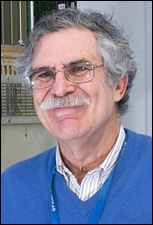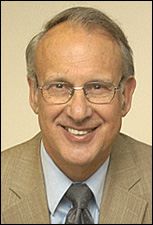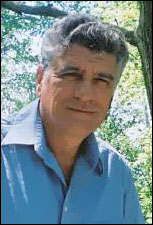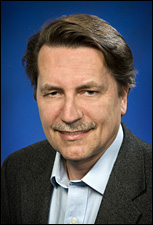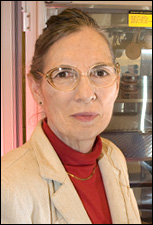Five Brookhaven Lab Scientists Named AAAS Fellows
January 16, 2009
UPTON, NY — The American Association for the Advancement of Science has awarded five scientists from the U.S. Department of Energy's Brookhaven National Laboratory with the distinction of Fellow. Howard Gordon, Fritz Henn, Serban Protopopescu, Thomas Roser, and Betsy Sutherland will be among 486 AAAS members to receive this honor for their efforts toward advancing science applications that are deemed scientifically or socially distinguished. The new Fellows will be presented with their official certificate and rosette pin on Saturday, February 14, during the 2009 AAAS Annual Meeting in Chicago.
Howard Gordon
Howard Gordon is recognized for his “distinguished contributions to the field of experimental high-energy physics, and, in particular, for leadership of the U.S. ATLAS construction project.”
Gordon helped coordinate the design and construction of the ATLAS detector at the Large Hadron Collider, the world’s most powerful particle accelerator, which recently began operating at CERN, in Geneva, Switzerland. Gordon has held several leadership positions within the U.S. branch of the ATLAS collaboration since 1996 and is currently the head of the U.S. ATLAS Program Office and deputy U.S. ATLAS operations program manager. He oversees nationwide and Brookhaven Lab-specific efforts to maintain and operate the detector and provides the computing and physics-analysis support to enable U.S. physicists to make discoveries with the data.
After receiving a Ph.D. in physics in 1970 from the University of Illinois, Gordon joined Brookhaven Lab in the same year. He rose through the ranks to become a senior physicist in 1984 while performing experiments at Brookhaven, CERN, Fermi National Accelerator Laboratory (Fermilab) and SLAC National Accelerator Laboratory. From 1981-2000, Gordon was the leader of Brookhaven’s Omega Group, which built key parts of the DZero detector at Fermilab’s collider, the Tevatron. A Fellow of the American Physical Society, Gordon has been deputy chair of Brookhaven’s Physics Department since 2007.
Fritz Henn
Fritz Henn is cited for “outstanding contributions to understanding neurodegenerative diseases and depression, for extensive service to the mental health community, and for inspired leadership of several psychiatric hospitals and research institutions.”
Henn is an expert in the neuroscience of depression, an area of research he has pursued for his entire career. Recently, he discovered a new neural circuit that, if stimulated electrically, can ease depression. He also found evidence that calls into question the theory that depression may be due to a decrease in the generation of new nerve cells. This research may lead to new, more effective treatments of depression.
A board-certified psychiatrist, Henn earned a Ph.D. in physiological chemistry from The Johns Hopkins University in 1967, and an M.D. from the University of Virginia in 1971. He performed his residency in the Department of Psychiatry at Washington University School of Medicine from 1971 to 1974. Henn began his career at the University of Iowa College of Medicine, and, in 1982, he joined Stony Brook University (SBU), where he became professor and chair of the Department of Psychiatry and Behavioral Medicine. In 1983 he became director of SBU’s Institute for Mental Health Research. Henn moved to Germany in 1994, to become the director of the Central Institute of Mental Health and professor of psychiatry at the University of Heidelberg. He was inducted into the German National Academy of Sciences, Leopoldina, and in 2008, he was awarded the New York Academy of Medicine’s Thomas William Salmon Award as well as the Federal Cross of Merit, awarded by the German President for Henn’s leadership and distinguished scientific contributions at the Central Institute. Henn joined Brookhaven Lab to assume his current position as associate director for Brookhaven’s Life Sciences Department in 2006.
Serban Protopopescu
Serban Protopopescu is recognized for “distinguished leadership in the DZero experiment at Fermi Lab, specifically involving the discovery of the top quark, and initiating studies of processes with tau leptons.”
Protopopescu was one of the original proponents of Fermi’s DZero particle detector and was a leader in the development of software for the detector. He co-led the top quark analysis group, developing analysis techniques for identifying this most massive quark, a subatomic particle discovered in 1995. In 2008, he joined Brookhaven’s ATLAS team to study final states with tau leptons and is presently at the Linear Accelerator Laboratory (LAL)in Orsay, France, for a nine-month sabbatical leave.
After earning a Ph.D. in experimental high-energy physics from the University of California, Berkeley, in 1972, Protopopescu joined Brookhaven during that same year. He spent one year as a visiting scientist at LAL and returned to Brookhaven in 1977. In 1988, he became a visiting associate professor at Stony Brook University, then returned to Brookhaven as a physicist in 1989. He became a Fellow of the American Physical Society in 2000.
Thomas Roser
Thomas Roser is cited for “distinguished contributions to the field of accelerator science, particularly for the development of polarized proton colliding beams at high energy.”
Roser significantly contributed to the design and construction of a string of magnets called Siberian snakes for Brookhaven’s world-class collider, the Relativistic Heavy Ion Collider (RHIC) and the Alternating Gradient Synchrotron (AGS), the accelerator that feeds polarized protons — subatomic particles that all spin in one direction — into RHIC. The partial “snakes” that Roser developed for the AGS stabilize polarization during acceleration, making it easier for physicists to study the particles.
Roser received a Ph.D. in physics from the Swiss Federal Institute of Technology in Zurich in 1984. He joined the University of Michigan in the same year as a research fellow and was appointed assistant professor of physics at the university in 1990. He joined Brookhaven Lab as an associate physicist in 1991, and, in 1994, he became the head of the Accelerator Division for Brookhaven’s AGS Department, which later became the Collider-Accelerator Department. In 2002, he also was appointed associate chair for accelerators. A Fellow of the American Physical Society, Roser received the Brookhaven Science and Technology Award in 2000.
Betsy Sutherland
Betsy Sutherland is recognized for “her outstanding contributions to understanding and characterizing the impact of DNA damage induced by low-dose radiation in higher organisms and repair of that damage.”
Sutherland has made numerous significant discoveries in her field of expertise — radiation research. Her current studies help NASA assess the hazards that astronauts face during space travel. With colleague Brigitte Paap, Sutherland developed a new technique that uses fluorescent “tags” instead of radioactive ones to monitor repair of damage to DNA, thereby reducing hazardous waste and the cost of research. This technique earned both biologists a “Best in Class” pollution prevention award from the U.S. Department of Energy’s Office of Science.
After earning a Ph.D. in molecular biophysics from the University of Tennessee in 1967. Sutherland completed her postdoctoral work at the Walter Reed Army Institute of Research and the University of California, Berkeley. She joined the faculty at the University of California, Irvine, in 1972 and came to Brookhaven Lab in 1977. Sutherland was awarded the 1985 Ernest Orlando Lawrence Memorial Award by the Department of Energy for her work on a DNA repair enzyme. Sutherland maintains an active radiation research program, which is funded by NASA and the U.S. Department of Energy. She is currently chair of Brookhaven’s Scientific Advisory Committee for Radiation Research and head of the Biology Department’s User Support Team for the NASA Space Radiation Laboratory (NSRL) at Brookhaven Lab. The NSRL provides the only source in the U.S. of high-energy charged particles used in assessing the effects of space radiation on biological systems, materials and instruments.
2009-10891 | INT/EXT | Newsroom




